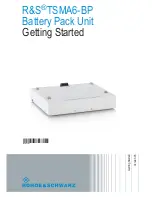
PERSONAL PRECAUTIONS
1. Someone should be within range of your voice, or close enough
to come to your aid, when you work near a lead-acid battery.
2. Have plenty of fresh water and soap nearby in case battery acid
contacts skin, clothing or eyes.
3. Wear complete eye protection and clothing protection. Avoid
touching eyes while working near battery.
4. If battery acid contacts skin or clothing, wash immediately with
soap and water. If acid enters eye, immediately flood with running
cold water for at least 10 minutes and get medical attention
immediately.
5. Be extra cautious to reduce risk of dropping a metal tool onto
battery. It might spark or short-circuit the battery or other
electrical part that may cause an explosion.
6. Remove personal metal items such as rings, bracelets, necklaces
and watches when working near a lead-acid battery. A lead-acid
battery can produce a short-circuit current high enough to weld a
ring or the like to metal, causing a severe burn.
7. Use this charger for charging LEAD-ACID batteries only. It is not
intended to supply power to a low voltage electrical system other
than in an automotive application. Do not use battery charger for
charging dry-cell batteries that are commonly used with home
appliances. These batteries may burst and cause injury to
persons and damage to property.
8. NEVER charge a frozen battery.
9. If it becomes necessary to remove the battery from the vehicle to
charge, always remove grounded terminal from battery first.
Make sure all accessories in the vehicle are off, so as not to
cause an arc.
10. Be sure area around battery is well ventilated while battery is
being charged. Gases can be forcefully blown away, by using a
piece of cardboard or other non-metallic material, such as a fan.
11. Add distilled water in each cell until battery acid reaches level
specified by battery manufacturer. This helps purge excessive
gas from cells. Do not overfill. For a battery without cell caps,
carefully follow manufacturer’s recharging instructions.
12. Study all battery manufacturer’s specific precautions such as
removing or not removing cell caps while charging and
recommended rates of charge.
MOUNTING CHARGER FOR CONTINUOUS USE
WARNING – Never alter ac line cord or plug provided. If it will not
fit in the outlet, have the proper outlet installed by a qualified
electrician. Improper connection can result in the risk of electric
shock.
1. Fasten the supplied mounting bracket to the charger with the
provided hardware as illustrated in Figure 1.
2. Slide the bottom flange of the mounting bracket under the
battery. The battery weight will hold the charger in place.
Your new battery charger has been designed and manufactured to
provide years of reliable service. This charger cannot be used on
positive ground systems without conversion (see MOUNTING
CHARGER FOR CONTINUOUS USE). Proper use and care can
prolong the life of the charger. This Operator’s Manual contains
information regarding safety, operation, maintenance and storage of
your new battery charger. Make sure that you, and anyone else who
will be using this charger, are familiar with this information.
IMPORTANT SAFETY INSTRUCTIONS
SAVE THESE INSTRUCTIONS
This manual contains important safety and operating instructions.
• Use of an attachment not recommended or sold by the
manufacturer may result in a risk of fire, electric shock or injury to
persons.
• To reduce the risk of damage to electric plug and cord, pull by plug
rather than cord when disconnecting charger.
• Use of an improper extension cord could result in a risk of fire and
electric shock. If an extension cord must be used, make sure:
1. that pins on plug of extension cord are the same number,
size, and shape as those of plug on charger;
2. that extension cord is properly wired and in good electrical
condition;
3. that wire size is large enough for ac ampere rating of this
charger as indicated in the following table.
RECOMMENDED MINIMUM AWG WIRE SIZE FOR
EXTENSION CORDS FOR THIS BATTERY CHARGER
Length of Cord, Feet
25
50
100
150
AWG Size of Cord
18
18
18
16
• Do not operate charger with damaged ac line cord or plug – replace
them immediately.
• Do not operate charger if it has received a sharp blow, been
dropped or otherwise damaged in any way; take it to a qualified
service person.
• Do not disassemble charger; take it to a qualified service person
when service or repair is required. Incorrect reassembly may result
in a risk of electric shock or fire.
• To reduce risk of electric shock, unplug charger from outlet before
attempting any maintenance or cleaning.
For this reason, it is critical that each time before using your charger,
you read this manual and follow the instructions exactly.
To reduce the risk of battery explosion, follow these instructions and
those published by battery manufacturer and manufacturer of any
equipment you intend to use in vicinity of battery. Review cautionary
markings on these products and on engine.
CAUTION – Connect or disconnect the battery clamps only when
the ac line cord is disconnected or arcing or burning may result.
CAUTION – Do not expose to rain; replace defective cords or
wires immediately.
OPERATOR’S MANUAL
MODEL NO. 1002 1.5 AMP 12 VOLT AUTOMATIC BATTERY CHARGER
























